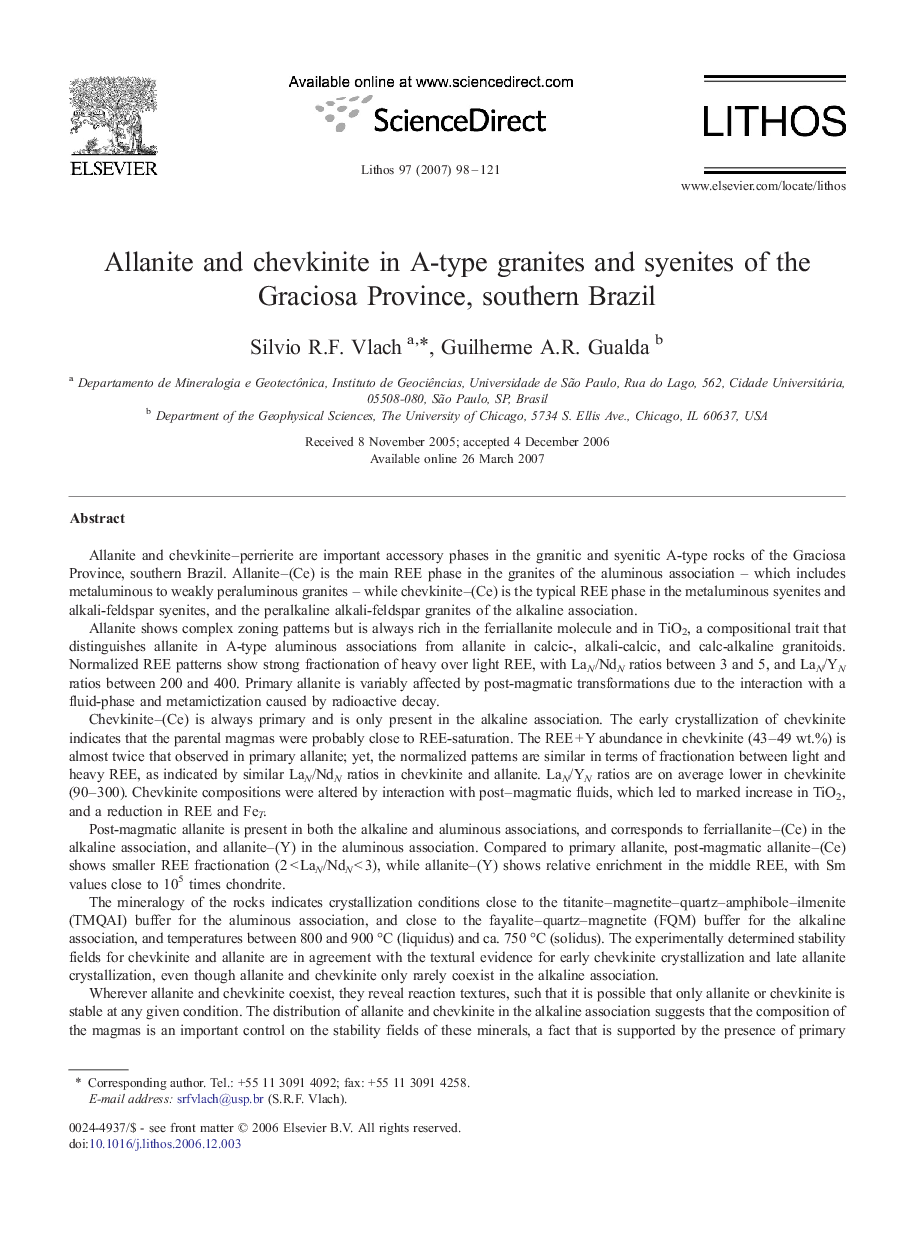| کد مقاله | کد نشریه | سال انتشار | مقاله انگلیسی | نسخه تمام متن |
|---|---|---|---|---|
| 4717712 | 1638766 | 2007 | 24 صفحه PDF | دانلود رایگان |

Allanite and chevkinite–perrierite are important accessory phases in the granitic and syenitic A-type rocks of the Graciosa Province, southern Brazil. Allanite–(Ce) is the main REE phase in the granites of the aluminous association – which includes metaluminous to weakly peraluminous granites – while chevkinite–(Ce) is the typical REE phase in the metaluminous syenites and alkali-feldspar syenites, and the peralkaline alkali-feldspar granites of the alkaline association.Allanite shows complex zoning patterns but is always rich in the ferriallanite molecule and in TiO2, a compositional trait that distinguishes allanite in A-type aluminous associations from allanite in calcic-, alkali-calcic, and calc-alkaline granitoids. Normalized REE patterns show strong fractionation of heavy over light REE, with LaN/NdN ratios between 3 and 5, and LaN/YN ratios between 200 and 400. Primary allanite is variably affected by post-magmatic transformations due to the interaction with a fluid-phase and metamictization caused by radioactive decay.Chevkinite–(Ce) is always primary and is only present in the alkaline association. The early crystallization of chevkinite indicates that the parental magmas were probably close to REE-saturation. The REE + Y abundance in chevkinite (43–49 wt.%) is almost twice that observed in primary allanite; yet, the normalized patterns are similar in terms of fractionation between light and heavy REE, as indicated by similar LaN/NdN ratios in chevkinite and allanite. LaN/YN ratios are on average lower in chevkinite (90–300). Chevkinite compositions were altered by interaction with post–magmatic fluids, which led to marked increase in TiO2, and a reduction in REE and FeT.Post-magmatic allanite is present in both the alkaline and aluminous associations, and corresponds to ferriallanite–(Ce) in the alkaline association, and allanite–(Y) in the aluminous association. Compared to primary allanite, post-magmatic allanite–(Ce) shows smaller REE fractionation (2 < LaN/NdN < 3), while allanite–(Y) shows relative enrichment in the middle REE, with Sm values close to 105 times chondrite.The mineralogy of the rocks indicates crystallization conditions close to the titanite–magnetite–quartz–amphibole–ilmenite (TMQAI) buffer for the aluminous association, and close to the fayalite–quartz–magnetite (FQM) buffer for the alkaline association, and temperatures between 800 and 900 °C (liquidus) and ca. 750 °C (solidus). The experimentally determined stability fields for chevkinite and allanite are in agreement with the textural evidence for early chevkinite crystallization and late allanite crystallization, even though allanite and chevkinite only rarely coexist in the alkaline association.Wherever allanite and chevkinite coexist, they reveal reaction textures, such that it is possible that only allanite or chevkinite is stable at any given condition. The distribution of allanite and chevkinite in the alkaline association suggests that the composition of the magmas is an important control on the stability fields of these minerals, a fact that is supported by the presence of primary allanite in rocks formed by processes of mixing and mingling of magmas. In this sense, the importance of composition on the stability of allanite and chevkinite may be larger than previously suggested.
Journal: Lithos - Volume 97, Issues 1–2, August 2007, Pages 98–121